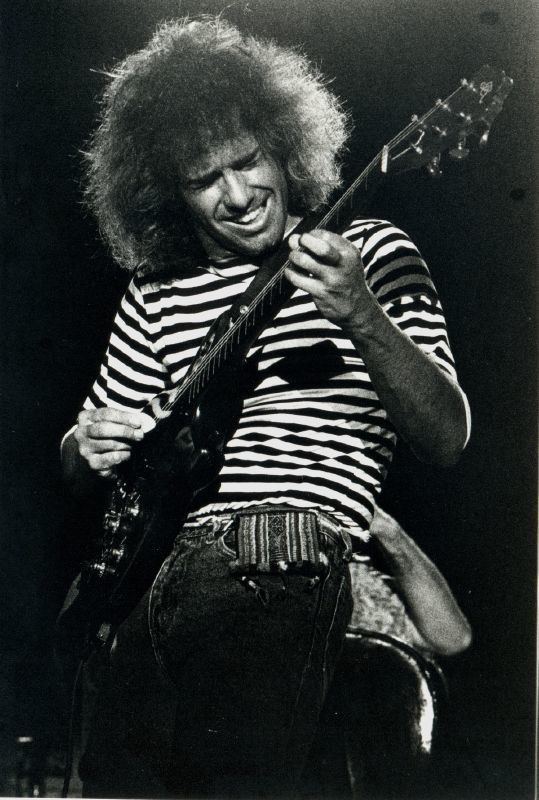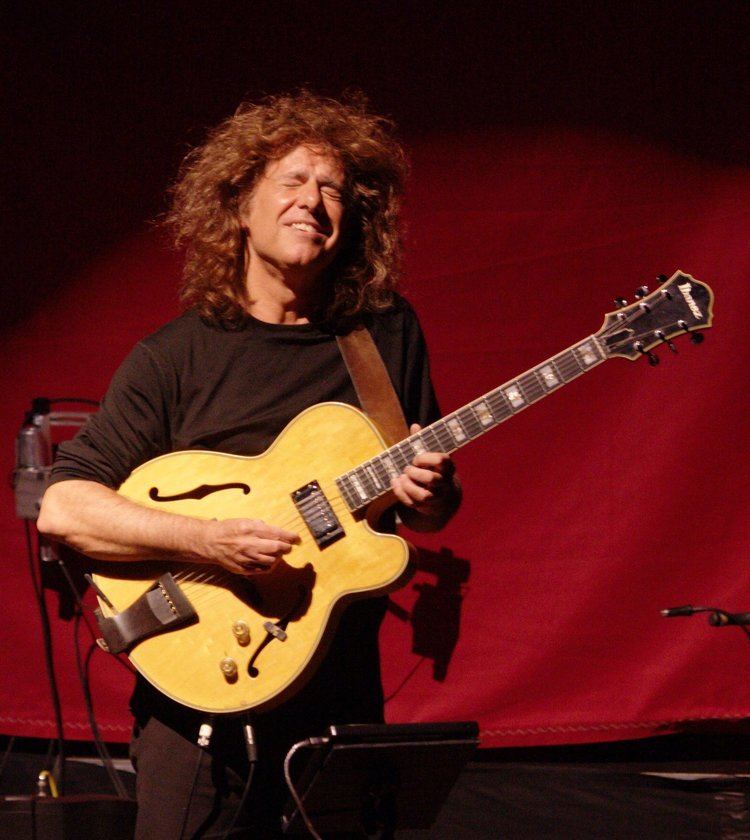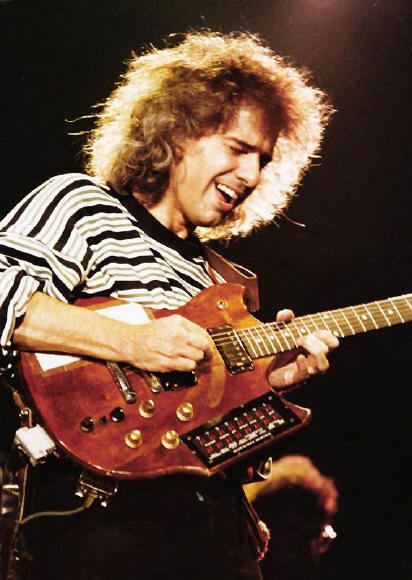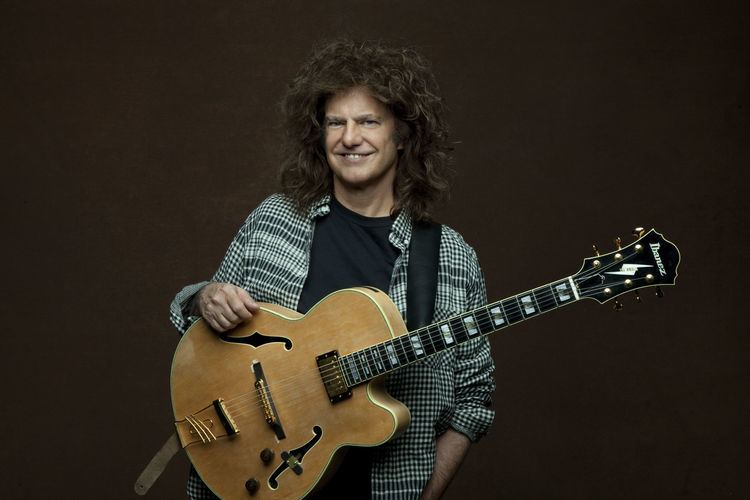Birth name Patrick Bruce Metheny Spouse Latifa Metheny Name Pat Metheny | Years active 1974–present | |
 | ||
Occupation(s) Musician, songwriter, composer Instruments Electric guitar, acoustic guitar, guitar synthesizer Role Guitarist · patmetheny.com Music group Pat Metheny Group (Since 1977) Albums Profiles | ||
Pat metheny and i love her the beatles
Patrick Bruce Metheny ( ; born August 12, 1954) is an American jazz guitarist and composer.
Contents
- Pat metheny and i love her the beatles
- The ibanez pat metheny interview
- Biography
- 19771985
- 19862006
- Side projects
- Unity Band
- Influences
- Pikasso
- Guitar synthesizer
- Six string and twelve string electric
- Awards and honors
- Grammy Awards
- Other
- Tribute albums
- References

He is the leader of the Pat Metheny Group and is also involved in duets, solo works and other side projects. His style incorporates elements of progressive and contemporary jazz, Latin jazz, and jazz fusion. Metheny has three gold albums and 20 Grammy Awards and is the only person to win Grammys in ten different categories. He is the brother of jazz flugelhornist and journalist Mike Metheny.

The ibanez pat metheny interview
Biography

Metheny was born and raised in Lee's Summit, Missouri, a suburb southeast of Kansas City. At age 15, he won a Down Beat scholarship to a one-week jazz camp and was mentored by guitarist Attila Zoller. Zoller invited the young Metheny to New York City to see guitarist Jim Hall and bassist Ron Carter. Following his graduation from Lee's Summit High School, Metheny briefly attended the University of Miami in Coral Gables, Florida in 1972, where he was offered a teaching position. He then moved to Boston to take a teaching assistantship at the Berklee College of Music with jazz vibraphonist Gary Burton. He established a reputation as a prodigy when he was with Burton.

In 1974 he made his recording debut on an album unofficially titled Jaco with pianist Paul Bley, bassist Jaco Pastorius, and drummer Bruce Ditmas for Carol Goss's Improvising Artists label. Metheny entered the wider jazz scene in 1975 when he joined Gary Burton's band, playing with guitarist Mick Goodrick. Metheny and Goodrick were interviewed together by Guitar Player magazine in 1975, bringing them to the attention of guitar aficionados around the world.
Metheny released his official debut album, Bright Size Life (ECM, 1976) with Jaco Pastorius on bass and Bob Moses on drums. His next album, Watercolors (ECM, 1977), was the first time he recorded with pianist Lyle Mays, who became his most frequent collaborator. The album also featured Danny Gottlieb, who became the drummer for the first version of the Pat Metheny Group. With Metheny, Mays, and Gottlieb, the fourth member was bassist Mark Egan when the album Pat Metheny Group (ECM, 1978) was released.
1977–1985
When Pat Metheny Group (ECM, 1978) album was released, the Group was a quartet comprising, besides Metheny, Danny Gottlieb on drums, Mark Egan on bass, and Lyle Mays on piano, autoharp, and synthesizer. All but Egan had played on Metheny's album Watercolors (ECM, 1977), recorded a year before the first Group album.
The second Group album, American Garage (ECM, 1979), reached number 1 on the Billboard Jazz chart and crossed over onto the pop charts. From 1982 to 1985, the Pat Metheny Group released Offramp (ECM, 1982); a live album, Travels (ECM, 1983); First Circle (ECM, 1984); and The Falcon and the Snowman (EMI, 1985), a soundtrack album for the movie of the same name in which they collaborated on the single "This Is Not America" with David Bowie. The song reached number 14 in the British Top 40 in 1985 and number 32 in the U.S.
Offramp marked the first appearance of bassist Steve Rodby (replacing Egan) and a Brazilian guest artist, the late Nana Vasconcelos, whose work on percussion and wordless vocals marked the first addition of Latin music shadings to the Group's sound, a trend which continued and intensified on First Circle with the addition of Argentinian singer and multi-instrumentalist Pedro Aznar, which also marked the debut of drummer Paul Wertico, replacing Gottlieb. Both Rodby and Wertico were members of the Simon and Bard Group at the time and had played in Simon-Bard in Chicago before joining Metheny.
1986–2006
First Circle was Metheny's last album with ECM; he had been a key artist for the label but left following disagreements with the label's founder, Manfred Eicher.
Still Life (Talking) (Geffen, 1987) featured new Group members trumpeter Mark Ledford, vocalist David Blamires, and percussionist Armando Marçal. Aznar returned for vocals and guitar on Letter from Home (Geffen, 1989).
During this period the Steppenwolf Theater Company of Chicago featured compositions by Metheny and Mays for their production of Lyle Kessler's play Orphans, where it has remained special optional music for all productions of the play around the world since.
Metheny then again delved into solo and band projects, and four years went by before the release of the next Group record, a live album titled The Road to You (Geffen, 1993), which featured tracks from the two Geffen studio albums among new tunes. The group integrated new instrumentation and technologies into its work, notably Mays' use of synthesizers.
Metheny and Mays themselves refer to the next three Pat Metheny Group releases as a triptych: We Live Here (Geffen, 1995), Quartet (Geffen, 1996), and Imaginary Day (Warner Bros., 1997). Moving away from the Latin style which had dominated the releases of the previous ten years, these albums included experiments with sequenced synthetic drums on one track, free-form improvisation on acoustic instruments, and symphonic signatures, blues, and sonata schemes.
With Speaking of Now (Warner Bros., 2002), new Group members were added: drummer Antonio Sánchez from Mexico City, trumpeter Cuong Vu from Vietnam, and bassist, vocalist, guitarist, and percussionist Richard Bona from Cameroon.
The Way Up (Nonesuch, 2005) consists of one 68-minute-long piece (split into four sections for CD navigation) based on a pair of three-note kernels: The opening B, A#, F# and the derived B, A, F#. On The Way Up, harmonica player Grégoire Maret from Switzerland was introduced as a new group member, while Bona contributed as a guest musician.
Side projects
Outside the Group, Metheny has shown different sides of his musical personality. He made the album Orchestrion (Nonesuch, 2010) with elaborate, custom mechanical instruments, allowing one person to compose and perform as a one-person orchestra. By contrast, his album Secret Story (Geffen, 1992) used orchestral arrangements found more often in movie soundtracks, such as his own The Falcon and the Snowman (EMI, 1985) and A Map of the World (Warner Bros., 1999). His solo acoustic guitar albums include New Chautauqua (ECM, 1979), One Quiet Night (Warner Bros., 2003), and What's It All About (Nonesuch, 2011). He explored the fringes of the avant-garde on Zero Tolerance for Silence (Geffen, 1994). This, too, was an album of solo guitar, but it was electric guitar, and to many fans and critics it was simply noise. Metheny had ventured into the avant-garde before on 80/81 (ECM, 1980), Song X (Geffen, 1986) with Ornette Coleman, and The Sign of Four with Derek Bailey (Knitting Factory, 1997). He recorded a more mainstream guitar duet with Jim Hall (Telarc, 1999), whose work has strongly influenced Metheny's. He collaborated with Polish folk singer Anna Maria Jopek on Upojenie (Warner Poland, 2002) and Bruce Hornsby on Hot House (RCA, 2005).
He recorded on albums by his older brother, Mike Metheny, a jazz trumpeter, among them Day In – Night Out (1986) and Close Enough for Love (2001).
The long list of his collaborators includes Bill Frisell, Billy Higgins, Brad Mehldau, Charlie Haden, Chick Corea, Dave Holland, Dewey Redman, Eberhard Weber, Herbie Hancock, Jack DeJohnette, Jaco Pastorius, John Scofield, Joni Mitchell, Joshua Redman, Marc Johnson, Michael Brecker, Mick Goodrick, Roy Haynes, Steve Swallow, and Tony Williams.
Unity Band
In 2012, he formed the Unity Band with Antonio Sánchez on drums, Ben Williams on bass and Chris Potter on saxophone. This ensemble toured Europe and the U.S. during the latter half of the year. In 2013, as an extension of the Unity Band project, Metheny announced the formation of the Pat Metheny Unity Group, with the addition of the Italian multi-instrumentalist Giulio Carmassi.
Influences
As a young guitarist, Metheny tried to sound like Wes Montgomery, but when he was 14 or 15, he decided it was disrespectful to imitate him. In the liner notes on the 2-disc Montgomery compilation Impressions: The Verve Jazz Sides, Metheny is quoted as saying, "Smokin' at the Half Note is the absolute greatest jazz-guitar album ever made. It is also the record that taught me how to play."
Ornette Coleman's 1968 album New York Is Now! inspired Metheny to find his own direction. He has recorded Coleman's compositions on a number of albums, starting with a medley of "Round Trip" and "Broadway Blues" on his debut album, Bright Size Life (1976). He worked extensively with Coleman's collaborators, such as Charlie Haden, Dewey Redman, and Billy Higgins, and he recorded the album Song X (1986) with Coleman and toured with him.
Metheny made three albums on ECM with Brazilian vocalist and percussionist Naná Vasconcelos. He lived in Brazil from the late 1980s to the early 1990s and performed with several local musicians, such as Milton Nascimento and Toninho Horta. He played with Antônio Carlos Jobim as a tribute, in a live performance in Carnegie Hall Salutes The Jazz Masters: Verve 50th Anniversary.
He is also a fan of several pop music artists, especially singer/songwriters including James Taylor (after whom he named the song "James" on Offramp); Bruce Hornsby, Cheap Trick, and Joni Mitchell, with whom he performed on her Shadows and Light (Asylum / Elektra, 1980) live tour. Metheny is also fond of Buckethead's music. He also worked with, sponsored or helped to make recordings of singer/songwriters from all over the world, such as Pedro Aznar (Argentina), Akiko Yano (Japan), David Bowie (UK), Silje Nergaard (Norway), Noa (Israel), and Anna Maria Jopek (Poland).
Two of Metheny's albums, The Way Up (2005) and Orchestrion (2010), show the influence of American minimalist composer Steve Reich and use similar rhythmic figures structured around pulse. Metheny recorded Reich's composition "Electric Counterpoint" on Reich's album Different Trains (Nonesuch, 1987).
Pikasso
Metheny plays a custom-made 42-string Pikasso I created by Canadian luthier Linda Manzer on "Into the Dream" and on the albums Quartet (1996), Imaginary Day (1997), Jim Hall & Pat Metheny (1999), Trio → Live (Warner Bros., 2000), and the Speaking of Now Live and Imaginary Day Live DVDs. Metheny has used the guitar in his guest appearances on other artists' albums. He used the Pikasso on Metheny/Mehldau Quartet (Nonesuch, 2007), his second collaboration with pianist Brad Mehldau and his trio sidemen Larry Grenadier and Jeff Ballard; the Pikasso is featured on Metheny's composition "The Sound of Water". Manzer has made many acoustic guitars for Metheny, including a mini guitar, an acoustic sitar guitar, and the baritone guitar, which Metheny used for the recording of One Quiet Night (2003).
Guitar synthesizer
Metheny was one of the first jazz guitarists to use the Roland GR-300 Guitar Synthesizer. He commented, "you have to stop thinking about it as a guitar, because it no longer is a guitar". He approaches it as if he were a horn player, and he prefers the "high trumpet" sound of the instrument. One of the "patches" that he has often used is on Roland's JV-80 "Vintage Synth" expansion card, titled "Pat's GR-300".. In addition to the Roland, he uses a Synclavier controller.
Six-string and twelve-string electric
Metheny was an early proponent of the twelve-string guitar in jazz. During his 1975 tour with the Gary Burton "Quartet" (five people, including Metheny), he primarily played electric twelve-string guitar against the six-string work of resident guitarist Mick Goodrick.
Prior to Metheny, Pat Martino had used the electric twelve-string guitar on a studio album, Desperado, and John McLaughlin had used a double-neck electric guitar with the Mahavishnu Orchestra. Ralph Towner was perhaps the first to use acoustic twelve-string guitar extensively in jazz ("The Moors", from Weather Report's I Sing the Body Electric, Columbia, 1972), and Larry Coryell and Philip Catherine made extensive use of acoustic twelve string in alternate tunings at the 1975 Montreux Jazz Festival, later releasing some of the material on their 1976 Twin House album.
Metheny used a twelve-string guitar on his debut album, Bright Size Life (1976), including alternate tuning on "Sirabhorn", and on later albums ("San Lorenzo", from Pat Metheny Group and Travels).
Awards and honors
Grammy Awards
Source:
